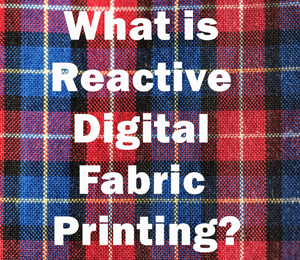There are different approaches to digital textile printing, and sometimes, it can be hard to choose the one that fits your design. There’s reactive printing, acid printing, pigment printing, dye sublimation, and disperse printing. Each printing process has its processes and benefits. It’s not a question of which one is the best, but which one is best suited to your project.
Let’s look at reactive digital printing on fabric and get to understand how it’s done.
What’s reactive printing?
The reactive printing process usually works by permanently locking color onto the fabric. The layer of applied ink, which comprises of reactive dyes, specific heat-activated additives, and a binder, is washed for them to set properly. Reactive printing allows fabric printing by Just Vision It to reach accurate, high-quality, and vibrant colors.
This process is suitable for most natural fabrics, specifically natural and protein, like silk, wool, cotton, cashmere, hemp, linen, etc. However, it’s not suitable when used to print synthetic fabrics and poly-based fabrics.
How does it work?
The reactive printing process uses reactive dyes combined with steam and permanently prints on fabric. The fabric you want to use is usually pre-treated, and inkjet is used to print the design using reactive dyes. Steam is then used where the high heat helps set the dye on the fabric. The pre-treated fabric, the reactive dyes, and high heat from the steam initiate a chemical reaction that forms a covalent bond, which infuses the different colors and designs onto the fabric. Lastly, the fabric is washed to remove the treatment and excess dyes, revealing high quality and vibrant colors.
The printing process
The reactive printing process consists of four stages:
- Pre-treatment – The fabric you wish to print is coated with a special pre-treatment in preparation for printing. This makes sure that the dye and the fabric bond together for the desired results.
- Printing – The reactive dye is then printed on your choice of fabric using an inkjet printer.
- Steaming – At this stage, a high-pressure steamer is used at a very high temperature on the printed fabric to lock the colors deep into the fibers. This ensures the print will last longer and avoid fading even after several washes.
- Final wash – After dyeing and the heat treatment, the fabric is washed to rid it of the pre-treatment solution and excess dyes.
What are reactive dyes?
Reactive dyes are inks that diffuse into the natural fibers of the fabric, creating a covalent bond between the fiber and the dye. It’s a good choice of printing because it also comes in various colors, which are extremely strong, and comes out with very high quality. Reactive color dyes achieve a very high color yield that’s infused into your garment, resulting in highly sophisticated print designs. You can use any design, as it doesn’t compromise on delicate and highly complex patterns. This also means that your design prints will stay vibrant even after several washes.
Reactive dyes when compared to pigment ink
Pigment dyes have been used for digital printing on fabric for a long time. The best thing about using pigment inks for printing is that you avoid the steaming process and the fabric’s extensive washes afterward. However, when using pigment ink, you still have to pre-treat your fabric before printing. Pigment dyes consist of chemical-binding elements. When compared to reactive dyes, they’re not environment-friendly.
In terms of bright colors, colorfastness, and fabric stiffness, pigment dyes are inferior to reactive dyes. Pigment dyes are best for printing interior decor accessories like furniture elements, trade show graphics, crafts, banners, flags, etc. With pigment dyeing, the ink sits on top of the fabric, and not as reactive inks where the fabric absorbs the ink. Because of this, fabrics printed with pigment inks tend to fade after a few washes.
When to use reactive inks, and when to use other inks
If the fabric you want to print is viscose or 100% cotton, then reactive inks are the best choice for printing. In conventional printing, pigment ink is preferred mainly because they are more affordable than reactive inks, but with the results appearing less vibrant. There’s no reliable digital printing ink, which is cheaper than reactive dyes with the same results or higher quality and brighter colors.
When printing wool or silk materials, you have to consider the application of the fabric. Is it a garment that will be subject to wear or will be washed frequently? In this case, it would be best to use reactive ink because it lasts longer and doesn’t fade. On the other hand, if you’re printing garments that don’t require too much washing and aren’t frequently used like scarfs and ties, acid inks are more suitable for printing.
Challenges of using reactive ink in digital textile printing
Although reactive inks provide digital printing companies with many benefits, the one thing they have been struggling with when using the ink is creating a unique deep black color. When digital printing ink started, black would appear as a form of grey. Now, they are always trying to develop a darker kind of black.
VS ink is a type of ink that produces powerful, vibrant colors, but it’s challenging to maintain stability during the steaming and washing stages. If you lost control during the steaming process, the black VS ink might turn out brown or even pink. MCT ink is better and easier to use than VS ink but produces less deep black colors.
Conclusion
The type of ink you use has a considerable influence on the results you’ll get. Therefore, you should ensure that you use the best ink available for your digital printing technique. Because of the many types of dyes available, it can be hard to choose, but now that you know all about reactive dyes and their benefits, you’re better positioned to make the right choice.
Follow Technoroll for more.
Editorial Staff of the TechnoRoll, are a bunch of Tech Writers, who are writing on the trending topics related to technology news and gadgets reviews.




